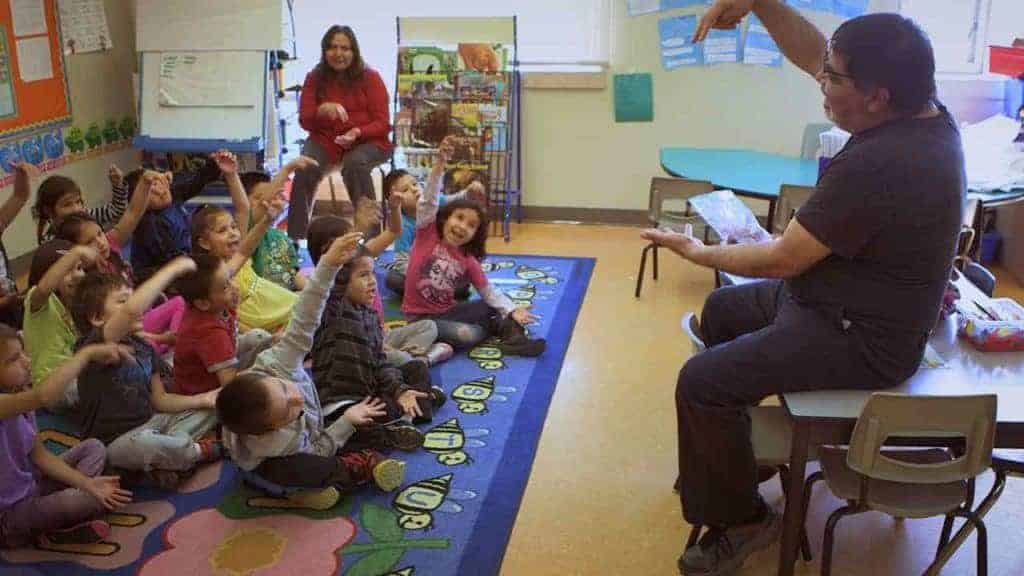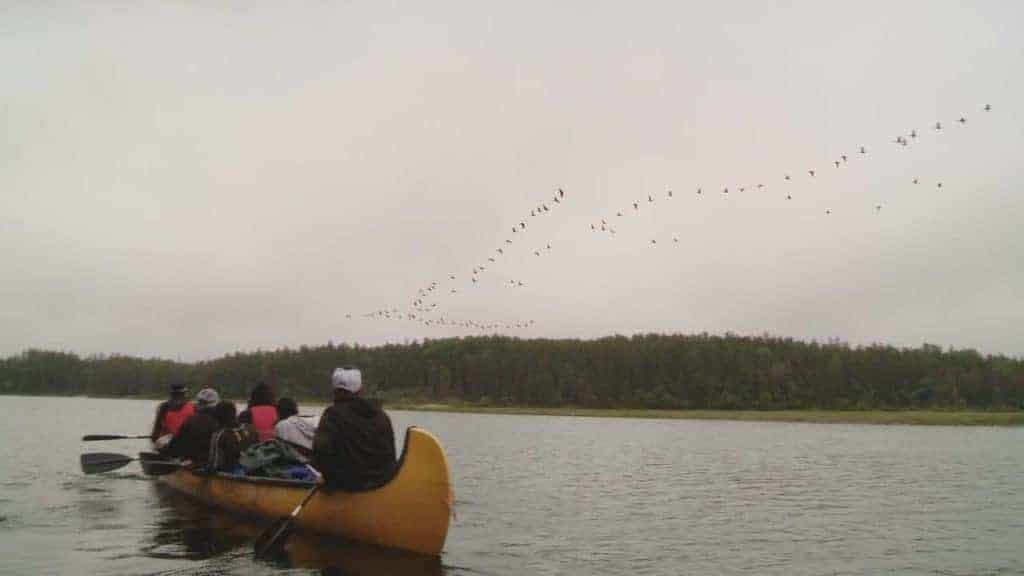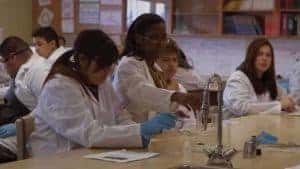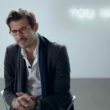Documentarian Alanis Obomsawin discusses Our People Will Be Healed, depicting community, gaining the trust of her subjects, and centering their voices in her 50th film on contemporary indigenous issues in Canada. This is an excerpt from our ebook In Their Own Words: Documentary Masters Vol 1, which is available to purchase here.

In Our People Will Be Healed, Alanis Obomsawin interviews students, teachers, parents, and elders of the Cree community of Norway House, about the Helen Betty Osborne Ininiw Education Resource Centre, a Nursery to Grade 12 school for over 1300 students in Manitoba. Obomsawin’s focus is on how the local school is lifting up the entire community. Unlike many schools in northern reserves, this one has a similar budget as the province’s others schools, which has enabled the school to invest in programs to make it more culturally relevant to the community. The school’s success, the film suggests, demonstrates that if only given an equitable chance, indigenous communities can heal from decades of abuse and neglect. This message rebuts common conservative arguments in Canadian media that government funding in indigenous communities perpetuates social problems by feeding a cycle of dependence.
Our People Will Be Healed is legendary Abenaki documentarian Obomsawin’s 50th film on contemporary indigenous issues made over her 50 years working for the Canadian National Film Board. It is the fourth entry in Obomsawin’s planned five-film cycle about how indigenous education and children’s rights are often still ignored by Canadian governments, despite promises. While each of the first three films stand alone, their themes provide essential context for the rarity of the success depicted in Our People Will Be Healed. Without this context, Our People Will Be Healed would seem misleadingly optimistic viewed on its own.
[clickToTweet tweet=”‘I don’t interpret. It’s the people who speak for themselves. I’m very careful about that.'” quote=”‘I don’t interpret. It’s the people who speak for themselves. I’m very careful about that.'”]
The first film, The People of the Kattawapiskak River (2012), focused on Attawapiskat, Ontario, an impoverished community that never received the government support promised under their treaty agreement. Hi-Ho Mistahey! (2013) followed the Shannen’s Dream movement for equal education funding. At the time, on-reserve schools received up to $3000 less per student than off-reserve schools.

We Can’t Make the Same Mistake Twice (2015) followed a court battle, by the First Nations Child and Family Caring Society, on equitable access to all government funded services for indigenous children. The case sought to enforce a bill called “Jordan’s Principle”, named after Jordan River Anderson, a disabled indigenous boy who died after living all five of his years in hospital while the federal and provincial governments argued over who would pay for the necessary home care. Jordan’s Principle would ensure that funding gets delivered first; only later would the levels of government settle who was responsible for it. Jordan Anderson will be the subject of Obomsawin’s next film, which is the planned conclusion of this cycle.
[clickToTweet tweet=”‘I never tire of listening to people. I love to listen to how people survive all kinds of things.'” quote=”‘I never tire of listening to people. I love to listen to how people survive all kinds of things.'”]
Obomsawin first travelled to Norway House while researching Jordan’s Principle. She “really fell in love with the children, and the school”. Here, Obomsawin found a counterpoint to the lack of funding and resources seen in other communities like Attawapiskat. “I’ve done hundreds of schools in my lifetime. Before making films, I was talking to students in the classroom. And I’ve never encountered such a school as I did in Norway House. It was very avant-garde and exciting to see the possibilities that should be there for all.”
For over 100 years, the Canadian government forced indigenous children into residential schools, where they were beaten for speaking their own language or recalling their own culture. While this attempt at cultural genocide ended near the close of the 20th century, schooling continues to be traumatic for indigenous communities. There is little support from the government for on-reserve schools to create a system that actually works for indigenous communities.
To read the rest of the interview with Alanis Obomsawin, purchase a copy of the ebook Documentary Masters: Vol. 1 here.
To read the rest of the interview, get the Documentary Masters Vol.1 ebook:
[clickToTweet tweet=”To gain trust with people ‘I come in and just do sound. I don’t come in with a camera’ – Obomsawin” quote=”To gain trust with people ‘I come in and just do sound. I don’t come in with a camera’ – Obomsawin”]
The Helen Betty Osborne school is trying to restore what they can of what was lost in this brutal history of schooling. The school aims to supplement the provincially mandated curriculum with culturally relevant courses and practices, such as Indigenous Studies and Languages classes. As one language teacher poignantly states in the film, “If they don’t know [the culture and language they are are losing], they don’t know something’s being taken away”. The school integrates a connection to the natural world into classes, organizes field trips, and invites community elders to mentor students.The school also starts high school classes an hour later so teenagers can sleep in slightly longer, as research suggests this improves learning outcomes. Taken together, these efforts have lowered once high dropout rates. To illustrate the change the school has brought to the community, for example, Obomsawin interviews several adults from the generation before the school opened in 2004, who recall their participation in teenage gang activities.

Obomsawin emphasizes listening as the key to portraying people’s stories. “I don’t interpret. It’s the people who speak for themselves. I’m very careful about that.” Her films were some of the first to centre the voices of Canada’s indigenous peoples rather than be “about them”. This sensitivity structures her practical approach to documentary filmmaking, which she views as itself a tool for healing.
“Documentary is a very powerful place to be in terms of telling the history, teaching languages, and people telling their story. It’s the best way because it’s their voice. I never tire of listening to people. I love to listen to how people survive all kinds of things.” Obomsawin lets interviews flow organically, listening for as long as the speaker needs, because “time is the best gift you can give somebody.”
[clickToTweet tweet=”Obomsawin sees her role as putting together voices of individuals to make a portrait of a community.” quote=”Obomsawin sees her role as putting together voices of individuals to make a portrait of a community.”]
She says it’s always the same process to gain trust with people: “I come in and just do sound. I don’t come in with a camera. When I feel I understand the community, and they know me, then I bring in a crew.” After doing so many films, gaining trust has become a lot easier, both because of experience and because of her reputation. “It can take more than one trip”. She returns to the same people and places, and she spends as much time with her interviewees as they would like. Our People Will Be Healed involved “going in and out [of Norway House] for a good five years”. Her reputation precedes her and helps: “It depends on the subject, but in general, people know me when I go there.”
[clickToTweet tweet=”‘A story is told with several people who are contributing to the story. It’s not just one person.'” quote=”‘A story is told with several people who are contributing to the story. It’s not just one person.'”]
As a documentarian, Obomsawin sees her role as putting together voices of individuals to make a portrait of a community. “You need all of it [multiple perspectives]. It becomes a story, and a story is told with several people who are contributing to the story. It’s not just one person.” Through this multi-layered portrait, she avoids focusing the narrative on individual solutions to problems. Instead, she emphasizes the solidarity needed for improvement. This isn’t the success story of a few exceptional students or teachers. Rather, it is the story of how an entire community has been buoyed by the support and control they have over their school.
Read The Seventh Row’s reviews and interviews from TIFF ’17 >>

